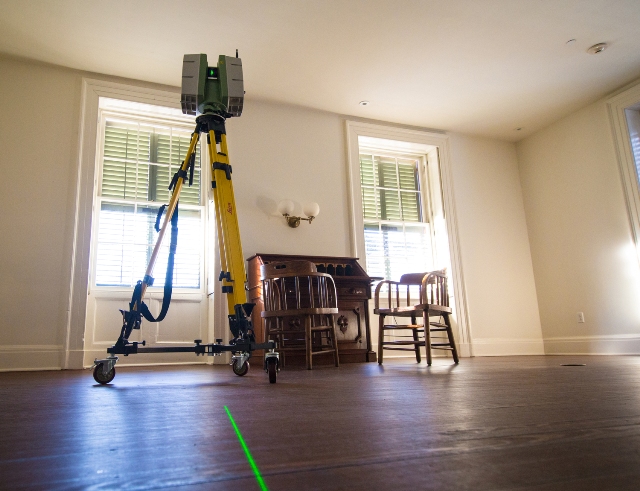Jan 19 2015
The historic Washington, D.C., home where Abraham Lincoln spent summers during his presidency and wrote his preliminary draft of the Emancipation Proclamation was recently lit up by a green laser, all in the name of preservation. A team of undergraduate students from Ithaca College traveled to Washington to document President Lincoln’s Cottage — the only designated national monument in the District of Columbia — using 3D laser scanning technology.
 Ithaca College researchers used 3D laser scanning technology to record the exterior and interior of President Lincoln's Cottage. Credit: Ithaca College
Ithaca College researchers used 3D laser scanning technology to record the exterior and interior of President Lincoln's Cottage. Credit: Ithaca College
The researchers recorded the exterior and most of the interior of the building using a Leica C-10 3D laser scanner that takes 50,000 readings per second. Images collected from the scanning will support preservation research, potentially impacting historical interpretation and public outreach at the site, which was used by Lincoln and his family to escape the summer heat of downtown Washington.
While in residence at the cottage, President Lincoln made crucial decisions about the Civil War and visited with wounded soldiers — it had previously served as a retirement home for veterans. He last visited the cottage the day before his assassination.
Now open to the public, it is operated by the National Trust for Historic Preservation, which through innovative guided tours, exhibits and programs hopes to inspire visitors to take their own path to greatness, preserving the cottage as an authentic, tangible connection to the past and a beacon of hope for all who take up Lincoln’s unfinished work.
“This great opportunity not only records the existing conditions of the cottage, it also provides a platform for us to document, manage and present future preservation projects to the public,” said Jeffrey Larry, preservation manager at President Lincoln’s Cottage.
The Washington Post published a helpful description of what the 3D laser scanning project will accomplish: Preservationists and researchers will be able explore an ultra-high-resolution image of the structure — floor to ceiling, inside and out — exact to two-tenths of an inch. Students a world away soon may be able to “fly” through the room where Lincoln freed the slaves.
Michael Rogers, associate professor in the Department of Physics and Astronomy at Ithaca College, and Scott Stull, lecturer in sociology/anthropology at SUNY Cortland, led the team of researchers. The week-long project was funded by a grant from Ithaca College.
Rogers has conducted research using 3D laser scanning technology, ground-penetrating radar and/or magnetometry at a variety of historic sites from the Revolutionary and French and Indian Wars, including Old Fort Johnson, Fort Klock and Fort Hardy.